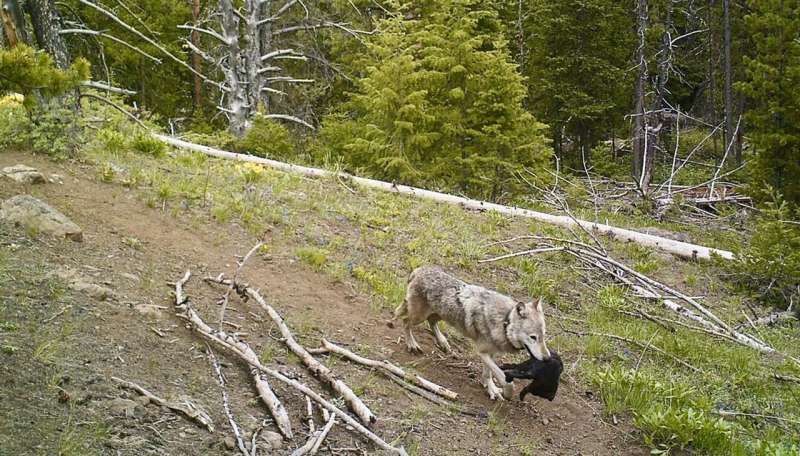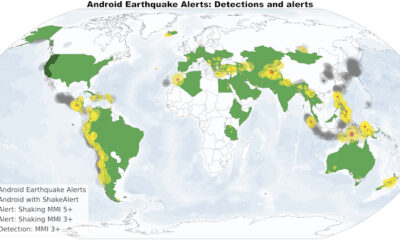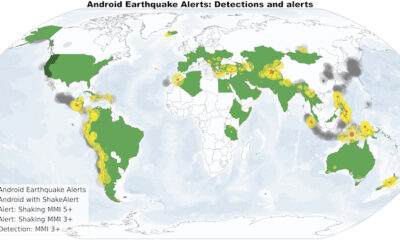Science
Gray Wolves Navigate Rugged Terrain with Pups During Elk Migration

Gray wolves, typically seen as den-bound during pup-rearing, have been observed traveling significant distances with their young in search of food. Researchers from the University of California – Berkeley documented these surprising behaviors near Yellowstone National Park, where wolves were seen covering over 20 kilometers of rugged terrain to reach migrating elk herds.
In a study published on August 1, 2025, in the journal Current Biology, the researchers noted that this is the first instance of gray wolves, outside of the Arctic, migrating to follow prey during the critical pup-rearing season. “The first time I saw a camera trap photo of a wolf carrying its pup, I just cracked up because the pup is being carried by its butt,” said Avery Shawler, the lead author of the study. This unexpected behavior underscores how adaptable gray wolves are to changing environmental conditions.
Wolves’ Adaptability and Elk Migration Patterns
The study challenges long-held assumptions that migratory hoofed animals can evade predation in spring due to predators being confined to their dens with immobile young. According to senior author Arthur Middleton, a professor of environmental science, policy, and management at UC Berkeley, understanding these adaptations is crucial for the conservation of both wolves and elk.
Wolves appear to be adjusting to the seasonal movements of their prey. The research team utilized GPS collars to track the movements of 19 gray wolves and 99 elk in the eastern Greater Yellowstone Ecosystem from 2019 to 2021. Their findings revealed that while some elk herds migrate short distances, others travel significantly further, prompting wolves to adopt different strategies.
Wolves that followed elk over long distances engaged in what the researchers termed “commuting,” where they temporarily left their home territories, as well as “migrating,” which involved moving to a new seasonal range. Some wolf packs were recorded carrying their young as far as 20 kilometers from their dens to rendezvous sites.
Implications for Conservation and Land Management
The implications of these findings are significant for conservation efforts, especially in areas where wolves and livestock coexist. Shawler emphasized that understanding wolf behavior can help land managers mitigate potential conflicts in ecosystems that include both ranches and wilderness. “In the U.S., more wolves live outside of protected areas than within,” Shawler noted. Consequently, as these wolves encounter human activities, it is vital to understand their changing behaviors.
Gray wolves were reintroduced to Yellowstone in 1995, and their population has grown to approximately 500 in the Greater Yellowstone Ecosystem. As climate change and land use alterations continue to impact both wolf and elk populations, researchers are closely monitoring these dynamics. Previous studies led by Middleton have shown that the timing of elk migrations is shifting, with herds arriving at winter ranges up to 50 days later than in previous years.
The California Wolf Project, co-led by Middleton, aims to explore similar dynamics in California, where around 10 wolf packs have been established since their recolonization in 2011. The project seeks to understand how the movements of deer and elk influence wolf behaviors, including interactions with livestock.
This pioneering research not only sheds light on gray wolves’ adaptability but also paves the way for future strategies in wildlife conservation and land management, emphasizing the intricate relationships between predator and prey in changing environments.
For more detailed information on the study, refer to the publication: Avery L. Shawler et al, “Wolves use diverse tactics to track partially migratory prey,” in Current Biology (2025). DOI: 10.1016/j.cub.2025.07.015.
-

 Entertainment1 month ago
Entertainment1 month agoAnn Ming Reflects on ITV’s ‘I Fought the Law’ Drama
-

 Entertainment2 months ago
Entertainment2 months agoKate Garraway Sells £2 Million Home Amid Financial Struggles
-

 Health1 month ago
Health1 month agoKatie Price Faces New Health Concerns After Cancer Symptoms Resurface
-

 Entertainment2 months ago
Entertainment2 months agoKim Cattrall Posts Cryptic Message After HBO’s Sequel Cancellation
-

 Entertainment1 month ago
Entertainment1 month agoWhere is Tinder Swindler Simon Leviev? Latest Updates Revealed
-

 Entertainment2 months ago
Entertainment2 months agoMasterChef Faces Turmoil as Tom Kerridge Withdraws from Hosting Role
-

 Entertainment3 months ago
Entertainment3 months agoSpeculation Surrounds Home and Away as Cast Departures Mount
-

 World1 month ago
World1 month agoCole Palmer’s Mysterious Message to Kobbie Mainoo Sparks Speculation
-

 Entertainment1 month ago
Entertainment1 month agoCoronation Street’s Carl Webster Faces Trouble with New Affairs
-

 Entertainment1 month ago
Entertainment1 month agoITV’s I Fought the Law: Unraveling the True Story Behind the Drama
-

 Entertainment3 weeks ago
Entertainment3 weeks agoCaz Crowned Winner of The Great British Sewing Bee, Overjoyed by Triumph
-

 Entertainment2 months ago
Entertainment2 months agoAldi Launches Cozy Autumn Fragrance Range Ahead of Halloween



















